
The Port Republic Road Historic District is a national historic district in Waynesboro, Virginia. In 2002, it included 83 buildings deemed to contribute to the historic character of the area, plus one other contributing structure and one contributing site, a foundation. They include buildings such as houses, garages, sheds, commercial buildings, churches, and meeting halls, and structures such as carports and animal sheds. The historically African-American neighborhood developed after the American Civil War. Notable buildings include the Shiloh Baptist Church (1924), the early-20th century Elks and Abraham lodges, the Rosenwald School, which incorporates a 1938-39 auditorium/gymnasium, and Tarry's Hotel (1940).

Earlysville Union Church, also known as Earlysville Free Union Church, is a historic church located on VA 743, northwest of the junction with VA 633 in Earlysville, Albemarle County, Virginia. It was built in 1833, and is a one-story, frame building with weatherboard siding and a gable roof on a low stone foundation. Entrance to the building is by two doors on the south gable end. It measures approximately 50 feet long by 30 feet wide. The building was originally one room; a small vestibule with flanking rooms for Sunday School rooms was partitioned off around 1880. It is a rare surviving example of interdenominational churches constructed at the beginning of the 19th century in Albemarle County. It was used the Baptists, Methodists and Presbyterians until the turn of the 20th century. The building continued in use as an interdenominational Sunday School for the community until 1977. In 1995, the building underwent restoration.
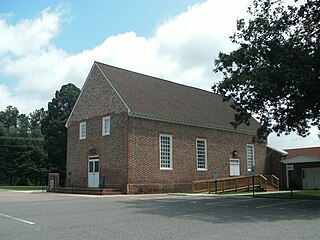
Mangohick Church, also known as Mangohick Baptist Church, is a historic Baptist church located in the community of Mangohick, King William County, Virginia. It was constructed in 1730, and is a one-story, rectangular brick building with a steep gable roof. It measures 61 feet by 21 feet. Originally built for an Episcopalian congregation, it was apparently abandoned by them soon after the Disestablishment. The church remains in active use.
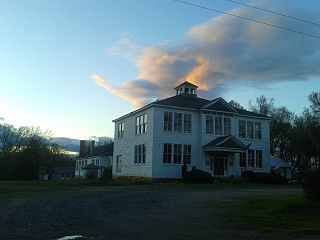
Hamilton High School is a historic high school building complex located at Cartersville, Cumberland County, Virginia, USA. It was constructed in 1910 and is a two-story wood-frame building, constructed in a local adaptation of the Classical Revival style. It has a hipped roof topped by a bell tower / cupola and is two bays deep and three bays wide, with an exterior footprint of 50 feet by 57 feet. An auditorium annex was added about 1925. A second annex, an agricultural classroom building now referred to as "the cannery" was added to the property about 1930, and the Wayside School, a one-room schoolhouse that was moved to the property from the vicinity of nearby Sportsmen's Lake between about 1935 and 1945.

The Matthew Fontaine Maury School, in Fredericksburg, Virginia, is an historic school building noted for its Colonial Revival architecture and design as well as its significance in the entertainment and cultural life of Fredericksburg. The architect of the building was Philip Stern. Built in 1919-1920, the school was used from then until 1952 for both elementary and high-school students. After the construction of James Monroe High School, the building was used as an elementary- and middle-school. The school was closed in 1980. Maury School was added to the National Register of Historic Places in March 2007.
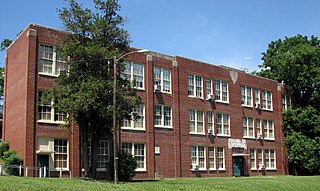
Walker–Grant School is a historic school in Fredericksburg, Virginia. The school was built in 1938 and was the first publicly supported black high school in Fredericksburg. The school was named for Joseph Walker and Jason Grant (1861–1951) who worked to establish the school. The Art Deco designed school was added to the National Register of Historic Places in October 1998.
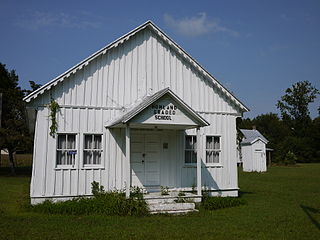
The Howland Chapel School is a historic school building for African-American students located near Heathsville, Northumberland County, Virginia. It was built in 1867, and is a one-story, gable fronted frame building measuring approximately 26 feet by 40 feet. It features board-and-batten siding and distinctive bargeboards with dentil soffits. The interior has a single room divided by a later central partition formed by sliding, removable doors. The building is a rare, little-altered Reconstruction-era schoolhouse built to serve the children of former slaves. Its construction was funded by New York educator, reformer and philanthropist Emily Howland (1827-1929), for whom the building is named. It was used as a schoolhouse until 1958, and serves as a museum, community center and adult-education facility.

St. Paul's School, also known as St. Paul's Chapel School, is a historic Rosenwald school building for African Americans located at Meredithville, Brunswick County, Virginia. It was built in 1920, and is a one-room school measuring approximately 20 feet by 40 feet. It is of wood-frame construction, sheathed in un-beaded weatherboards, and covered by a standing seam metal roof.

Josephine City School is a historic school building for African-American children located at Berryville, Clarke County, Virginia. It was built about 1882, and is a rectangular, one-story, frame building with a gable roof and a four-bay side gable entrance facade. The school measures approximately 40 feet long and 30 feet wide. It is part of a school complex for African American children that included the Josephine City School; the 1930 brick Clarke County Training School; and a 1941 frame building that was constructed as additional agriculture classrooms. It was used as an elementary school until 1930, when it was moved a short distance from its original location, and used as the Clarke County Training School's home economics and agriculture classrooms. It was used for classrooms until 1971, when it was turned into storage space, after which it was converted into low/moderate-income elderly housing.
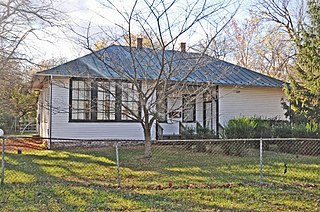
Millwood Colored School, now known as Millwood Community Center, is a historic school building for African-American children located at Boyce, Clarke County, Virginia. It was built about 1910, and is a one-story, hip-roofed school has a two-room plan with coat closets, and a kitchen. The building measures approximately 60 feet long and 30 feet wide. It features a recessed entry, two entrance doors, overhanging eaves with scalloped exposed rafter ends, double-hung windows with wooden tracery, five-panel doors, and sits on a limestone foundation. It was used as an elementary school until 1952, then sold to the Millwood Good Will Association for use as a community center.

Eckington School, also known as Poplar Ridge School, is a historic school building for African-American children located near Culpeper, Culpeper County, Virginia. It was built in 1895, and is a one-story, vernacular frame structure. It measures 20 feet by 26 feet, and is clad in weatherboard. It was used as a school until 1941, after which it was used as a church hall for the adjoining Free Union Baptist Church. At that time, a 10 foot by 20 foot addition was built.

Woodville School is a historic Rosenwald school building located at Ordinary, Gloucester County, Virginia. It was built in 1923, and is a high one-story, five bay, symmetrical frame structure. It measures 63 feet, 6 inches, by 28 feet, 6 inches, and sheathed in white painted clapboard. It was converted to residential use after 1942. Also on the property are a contributing guesthouse or additional school building and a small shed.

Lower Church is a historic Episcopal church located near Hartfield, Middlesex County, Virginia. It was constructed in 1717, and is a one-story, rectangular brick building with a clipped gable roof. It measures 56 feet by 34 feet.

Hamilton Schoolhouse is a historic one-room school building located near Lexington, Rockbridge County, Virginia. It was built in 1823, and is a one-story, one room log building measuring 22 feet by 24 feet. It was in use as a school until 1928, after which it was used as a community center.

Mason–Dorton School, also known as Mason's Store School and Dorton School, is a historic school building located at Castlewood, Russell County, Virginia. It was built in 1885, and is a one-story, two-room, frame building. It measures approximately 46 feet by 24 feet. The school has a gable roof and is sheathed in weatherboard. The school closed in 1958.

Norfolk & Western Railway Depot is a historic railway depot located at Marion, Smyth County, Virginia. It was built in 1904 by the Norfolk and Western Railway. It is a one-story, stone and brick, Queen Anne style building. It features detailed porches supported by arching brackets on the street side and iron columns on the other three sides and a slate and shingled hipped roof with dormers. The building measures 25 feet by 128 feet, and has an attached former ticket office. The building was converted for office and retail use in 1993–1994.

Stonega Historic District is a national historic district located at Appalachia, Wise County, Virginia. The district encompasses 80 contributing buildings in the coal company town of Stonega. It includes a variety of residential, commercial, institutional, and industrial buildings built after the towns' founding in 1895. Notable buildings include the Catholic Church, Stonega Colored Methodist Church, Stonega Colored School / Community Building, Stonega Bath House, and Stonega Colored School.

Portsmouth Courthouse, also known as Norfolk County Courthouse, is a historic courthouse building located at Portsmouth, Virginia, United States. It was built in 1846, and is a one-story with basement, Greek Revival style brick building. It measures 78 feet wide by 57 feet deep. The building is topped by a paneled parapet with Doric order entablature supported by plain Greek Doric pilasters. The building remained in use as a courthouse until 1960, when the county government moved to Great Bridge.

The Carver Industrial Historic District is a national historic district located at Carver, Richmond, Virginia. The district encompasses 13 contributing buildings located west of downtown Richmond. The industrial area developed between 1890 and 1930, along the tracks of the Richmond, Fredericksburg and Potomac Railroad. The buildings are in a variety of popular 19th-century and early 20th century architectural styles including Queen Anne and Romanesque.
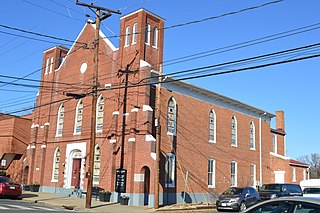
The Shiloh Baptist Church (Old Site) is a historic Baptist church at 810 Sophia Street in downtown Fredericksburg, Virginia. The church is a two-story brick building with predominantly Classical Revival styling, modeled to some degree after the Presbyterian Church of Fredericksburg, with later alterations. The church was built in 1890 for a predominantly African-American congregation, whose origins lie in a mixed-race Baptist congregation founded in 1804. That congregation split about 1815, worshipping in a building at this site, and became known as the Shiloh Baptist Church with the construction of a new building here in the 1830s. In 1849 the large congregation again divided, with most of its white members leaving to form the Fredericksburg Baptist Church at Princess Anne and Amelia Streets. Services were discontinued during the American Civil War, and the existing building was damaged, in part due to abuse caused during military occupation of the city. It collapsed in 1886, and the present building was constructed in 1890 as its replacement. However, due to a schism in the congregation, two separate groups claimed the name "Shiloh Baptist", which was resolved by giving the one at this location the name "Shiloh Baptist Church (Old Site)", which it still retains.
























